Google, Microsoft Go To War For Most Important Technology Ever
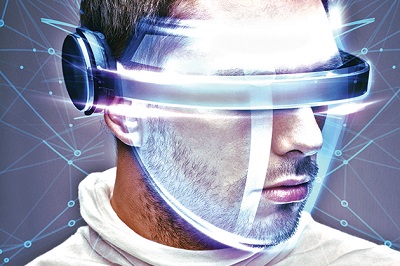
VIRTUAL REALITY
PREFACE
The world changing technologies have surrounded communications and transportation.
While there are some amazing technologies proliferating, like streaming video on demand, or self-driving cars, none of these will actually change the world. But there is one movement, one technology that is the next step both in the communications revolution and the transportation revolution.
“
This is a technology whose consumer base looks increasingly like [all of] humanity.
This is a technology whose consumer base looks increasingly like [all of] humanity.
”
Source: Dave Thier, Forbes
Of course, we're talking about virtual (and augmented) reality and two mega caps, Microsoft (NASDAQ:MSFT) and Alphabet Inc. (NASDAQ:GOOGL) have gone to war to own it.
THE PRIZE
Together VR is projected to hit $150 billion in yearly sales by just 2020, according to a study by digi-capital:
VIRTUAL REALITY MARKET
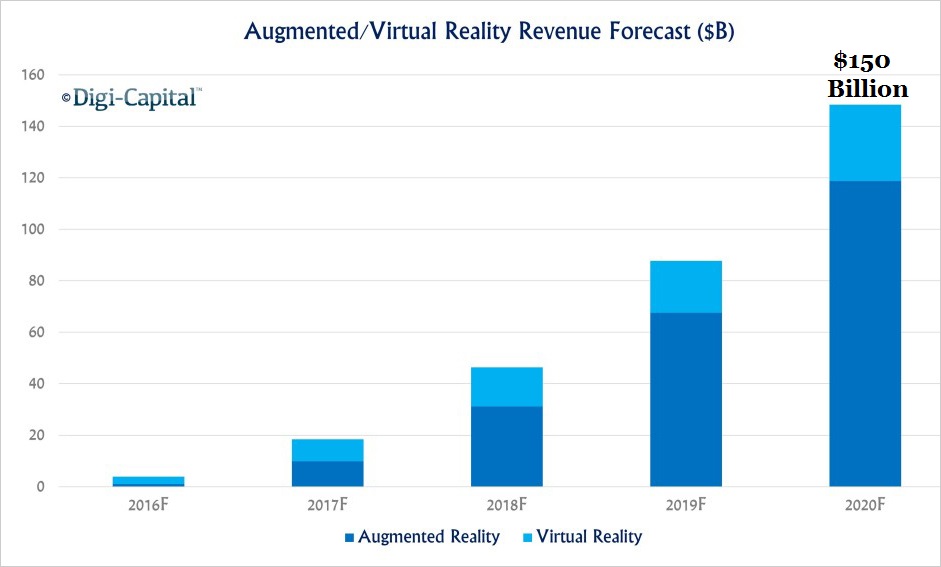

But those numbers are too small and here's why:
WHY IT'S SO BIG
We can sit in the same room as a family member 10,000 miles away. Have a meal with anyone we know at any time in any place. We can sit on the 50-yard line at the Super Bowl. We can sit front row at the State of the Union. We can visit Mars, be an airplane pilot, and go to an African Safari.
Further yet, we can treat anxiety disorders, phobias, even expand the reach of education and further children's imaginations, even adult imagination. Not to get crass, but even sexual encounters will be possible from anywhere at any time. Touch, the physical sense, is now possible. Here's a little image from MIT:
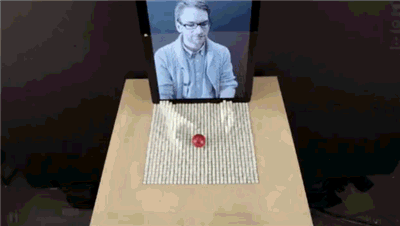
It's that real. Sight, hearing, and touch have already been conquered.
Virtual and Augmented Reality technology is moving so fast, that when we're with someone miles away in a VR experience, it doesn't look like a video game or animated rendering, it's real. If you've never experienced it -- go to a demonstration and feel the enormity of these realties within 15 seconds. It's that powerful and it's that obvious, that quickly.
WAR: MICROSOFT
Microsoft wants to do for virtual reality what it did for PCs, which is, make it as ubiquitous as possible. Every household, every workplace, everyone has it, uses it, depends on it and lives by it.
Microsoft has created its Windows Holographic platform with an eye to turning it into the standard operating system for virtual reality, like it did with Windows when personal computers first hit the market.
Here's what Microsoft presented at Computex:
“
Windows Holographic is coming to devices of all shapes and sizes from fully immersive virtual reality to fully untethered holographic computing.
[We're looking ahead] to the future of computing, where the physical and virtual worlds intersect in all new ways, and create further scale for the Windows platform."
Source: CNN Money
Windows Holographic is coming to devices of all shapes and sizes from fully immersive virtual reality to fully untethered holographic computing.
[We're looking ahead] to the future of computing, where the physical and virtual worlds intersect in all new ways, and create further scale for the Windows platform."
”
Source: CNN Money
This is a different and far more combative strategy than Microsoft initially appeared to be pursuing, which was to sell its HoloLens headset and let it compete with Facebook's (NASDAQ:FB) Oculus, HTC's Vive and Apple's soon to be named VR product.
With Microsoft Corporation (NASDAQ:MSFT), its Windows Holographic is described like this:
“
It won't matter that one person is wearing a HoloLens or that someone else is wearing an Oculus headset or the HTC Vive.
Windows Holographic devices and applications will be able to take data from each of the devices and render them together.
Source: CNN Money
It won't matter that one person is wearing a HoloLens or that someone else is wearing an Oculus headset or the HTC Vive.
Windows Holographic devices and applications will be able to take data from each of the devices and render them together.
”
Source: CNN Money
Bloomberg wrote:
“
Partners will be encouraged to build personal computers, displays and accessories for the platform to develop experiences mixing the reality technologies.
Source: Bloomberg
Partners will be encouraged to build personal computers, displays and accessories for the platform to develop experiences mixing the reality technologies.
”
Source: Bloomberg
In other words, rival headset makers can connect to Hololens and each other through the new Windows platform. Intel, Lenovo, Dell, Acer, HTC and ASUS have already signed on to use Windows Holographic. But then there's Google.
WAR: GOOGLE
At its most recent I/O conference, Google introduced the idea of its new headset called Daydream. The combative stance from Google is one that focuses on smartphones with a headset that turns existing phones into the screen.
Google's open source Android mobile operating system dominates the smartphone world. Sticking with its open source strategy, even though Google is participating in the creation of "Daydreams," it will also provide the designs for hardware to Android phone makers so they can produce and sell their own versions.
Here's a great take from CNN Money, when they write:
“
Google's approach focuses on reaching the widest number of people instead of creating the best, most immersive VR experience.
A smartphone-based headset might not blow as many minds, but it can help speed up VR's adoption.
Source: CNN Money
Google's approach focuses on reaching the widest number of people instead of creating the best, most immersive VR experience.
A smartphone-based headset might not blow as many minds, but it can help speed up VR's adoption.
”
Source: CNN Money
So, while Facebook (NASDAQ:FB), Amazon (NASDAQ:AMZN), Apple (NASDAQ:AAPL), International Business Machine (NYSE:IBM) and China's Baidu (NASDAQ:BIDU) are already in the space, it's these two tech giants that are each making a bet on the future of VR -- one is PC based, one is mobile.
Now we get to choose which one will in. Of course, there is another approach -- to find the technology that will power all of it, regardless of the operating system that wins.
WINNER
This is the opportunity so many investors say they welcome -- say they search for. The opportunity to find the "Next Apple," or the "next Google." We listed a number of tech giants above, but all of them, every single one, are totally and utterly dependent on the back bone of VR -- and that is computing speed.
VR is now "here again" for one very simple reason. One technology company has finally broken the barrier in providing the enormous computing power to make all of these grand statements a reality. What the public, you and I, will not tolerate is a rendering of our augmented or virtual realities that isn't absolutely 100% real. As a populace we no longer have the patience or interest in graphics that look like the 'Atari.'
We want it real -- not a rendering of real. And that is now possible. It isn't Artificial Intelligence, it's Artificial Superintelligence.
“
Another wave of progress in machine learning [] will mark a huge step in the evolution toward an Artificial Superintelligence.
Source: Tech Crunch
Another wave of progress in machine learning [] will mark a huge step in the evolution toward an Artificial Superintelligence.
”
Source: Tech Crunch
One company is this backbone, and it stands to gain the most from Virtual reality, which will in fact be the most important technology ever, until the next step forward.
WHY THIS MATTERS
This is just the surface analysis. There's so much going on with technology it's impossible to cover in one report. But, to take it a step further and to actually find the 'next Apple' or 'next FANG stock' we have to get ahead of the curve. This is what CML Pro does. Our research sits side-by-side with Goldman Sachs, Morgan Stanley and the rest on professional terminals, but we are the anti-institution and break the information monopoly that the top .1% have.
Each company in our 'Top Picks' is the single winner in an exploding thematic shift like artificial intelligence, Internet of Things, drones, biotech and more. In fact, here are just two of the trends that will radically affect the future that we are ahead of:
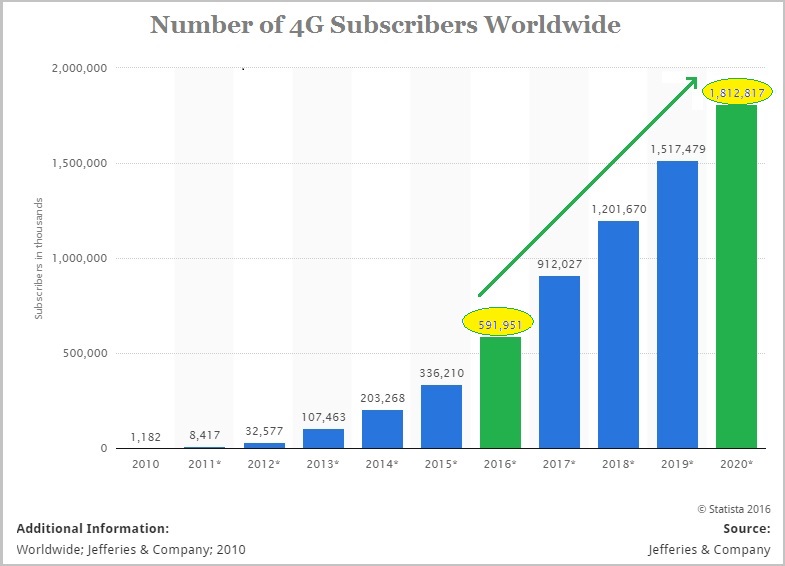
That chart plots the growth in 4G usage worldwide and how it will grow from 330 million people today to nearly 2 billion in five years. This is the lifeblood fueling every IoT and mobile device on the planet and CML Pro has named the single winner that will power this transformation. Then there's cyber security:
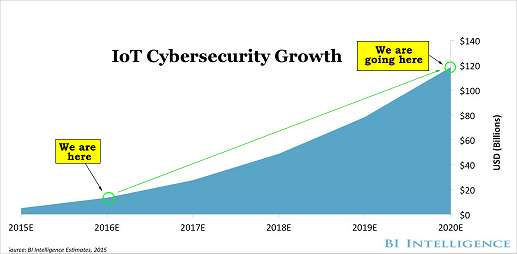
Market correction or not, recession or not, the growth in this area is a near certainty, even if projections come down, this is happening. CML Pro has named the single best cyber security stock to benefit from this theme.
These are just two of the themes we have identified and this is just one of the fantastic reports CML Pro members get along with all the visual tools, the precious few thematic top picks for 2016, research dossiers and alerts. For a limited time we are offering CML Pro at a 90% discount for $10/mo. with a lifetime guaranteed rate. Join Us: Get the most advanced premium research delivered to your inbox along with access to visual tools and data that until now has only been made available to the top 1%.
Thanks for reading, friends.


